Reminiscent of a miniature palm tree dracaena often adorns the windowsills of apartments and offices. A plant from the Dracene family with an elegant upright trunk and flowing leaf plates of various colors attracts with originality and unpretentiousness.
Material Content:
Description of species and varieties of dracaena
In the wild, the genus has about 150 species represented by trees or succulent shrubs that grow in the tropical, subtropical climate of Africa, Asia and America.

Some of the varieties are grown as potted plants:
- Dracaena Marginata is a plant with a bunch of thin green leaves, which are decorated at the edges with a red-violet border.
- Dracaena deremskaya is a species with lanceolate leaves of green color growing upwards, which begin to fall with age. Based on the type variety, several varieties are bred that are effectively distinguished by variegated foliage: Bausei with a wide white stripe in the center of the foliage, bordered by Shriveriana.
- Canarian dracaena - a species also known as the "dragon tree", is represented by tree-like plants with long bluish leaves, the ends of which are crowned with thorns. While providing optimal lighting, the edges of decorative sheet plates effectively stand out with a reddish tint.
- Dracaena Sander is an original variety with long narrow leaves of dark green color with silver stripes.
- Escherichia dracaena is a branchy shrub whose pointed foliage is decorated with yellowish stains.
- Dracaena bent - branching from the base of the plant species resemble fluffy bushes with bright greenery.
- Dracaena Godsefa is a shrub that is radically different from other species with oval leaf plates, the brightness of which is expressively emphasized by cream spots.
- Fragrant dracaena - its name is due to the pleasant aroma that the flowers exude. Since flowering is extremely rare at home, the variety is valued for decorative leaves of various colors. Popular varieties: fast-growing Lemon Lime, variegated Victoria, Massangeana, dark green variety Compacta.
The nuances of growing plants

In order for an exotic plant with high decorative qualities to develop well, it is necessary to create optimal conditions for the flower, close to natural.
Location and lighting

A flower with monophonic dark green leaves is undemanding to lighting and feels great even in the depths of the room. Variegated forms are recommended to be placed closer to the light source, protecting the plant from direct sunlight, which can burn decorative foliage. The optimal location of dracaena is considered to be the window sills of the eastern and western windows that do not open for ventilation. In the spring and summer, you can transfer the pot to fresh air in a place that is protected from drafts and the open sun.
Temperature
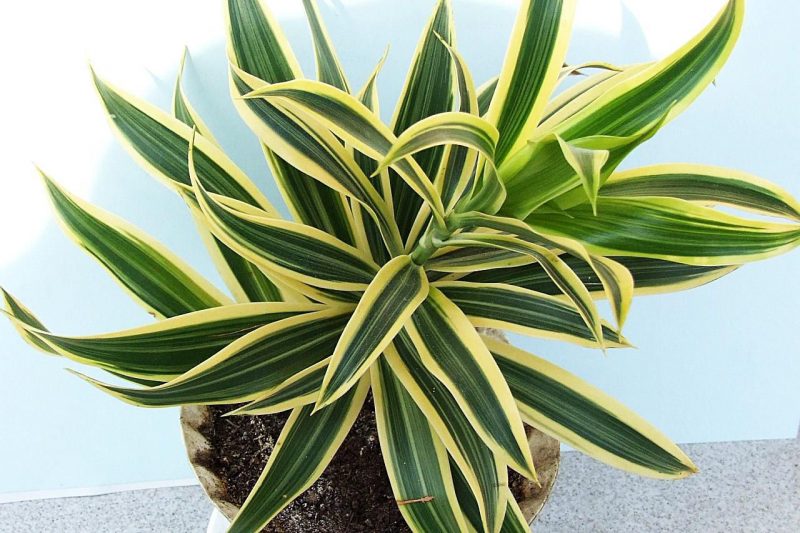
The thermophilic representative of the tropical flora grows well at room temperature. In the summer, the optimal temperature values can vary within the range of 20-25 ° C. In winter, the mercury column of the thermometer should be monitored so that it does not fall below the 15 ° C mark, which can lead to hypothermia of the flower and its death.
Humidity

Under natural conditions, dracaena grows in the tropics and loves an increased level of humidity. To dry indoor air does not harm the decorative qualities of the culture, regular spraying is required. Moisture-loving dracaenas perfectly respond to a warm shower, which also allows you to remove dust from the leaves, and prevent the appearance of various harmful insects.
The soil

Dracaena is undemanding to the soil composition and grows well in almost any soil with a loose structure that provides free air access to the roots and good water throughput. To fill the pot, you can use the universal soil mixture purchased in the store, or make up of turf, sheet soil, peat and sand in equal parts.
Home Care for Dracaena
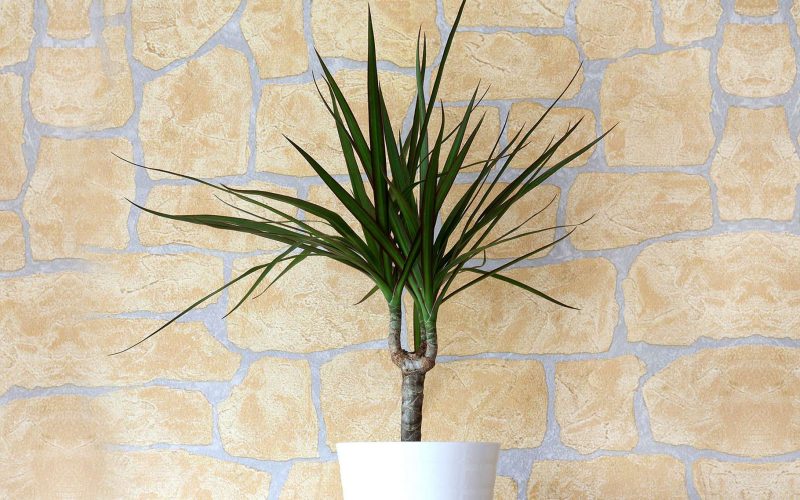
Successful cultivation of dracaena of any kind provides for the implementation of comprehensive care.
Watering a plant
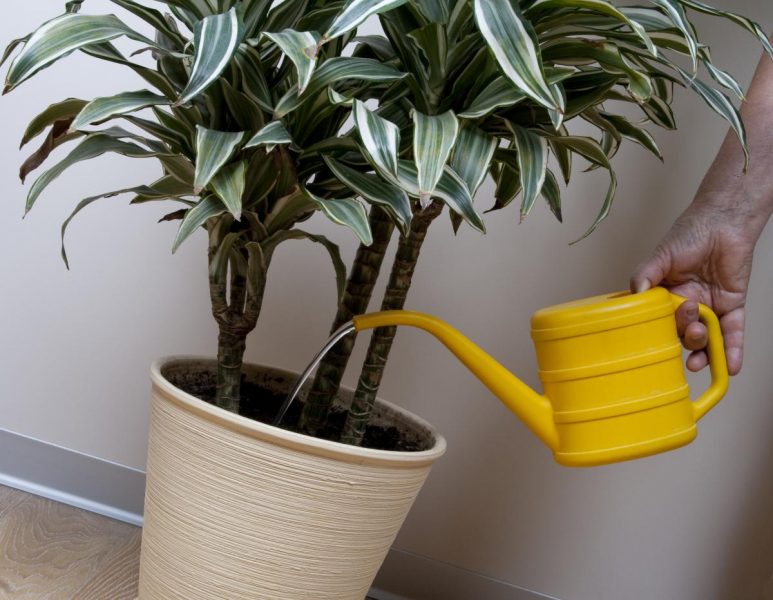
Dracaena loves not only high humidity, but also soil. It is recommended to water the crop abundantly after a little drying of the surface layer to avoid stagnation of water in the roots. In winter, the frequency of humidification is reduced. For irrigation, warm, pre-settled or filtered water is used.
It is interesting:dracaena marginata at home
Fertilizer and fertilizer
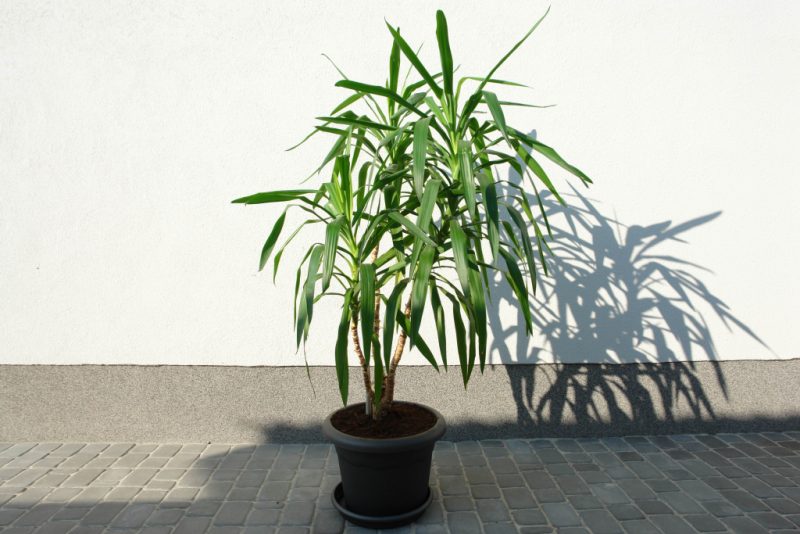
During the period of intensive vegetation, dracaena of any kind are fed every 2 weeks. As nutrient complexes, liquid mineral fertilizers are used, including nitrogen, and an increased concentration of phosphorus and potassium.
Transplant and pruning

After the tree reaches its maximum height, the stem stretches and exposes itself, as the lower leaves die off. To restore the decorative appearance of a false palm tree, you should rejuvenate the flower by cutting off the upper part and rooting it.
The transplant procedure, which may be accompanied by rejuvenation (reproduction), for young specimens is carried out annually. Adult plants are transplanted every 3-5 years.However, every spring it is recommended to restore the fertility of the earthen coma by removing the upper part of the old substrate and adding fresh ones.
When transplanting:
- A new container with a slightly larger diameter is disinfected.
- The bottom is covered with drainage material, which is crushed by the prepared soil.
- Dracaena with an old earthen lump is transferred into a prepared pot.
- The voids are filled with fresh soil mixture.
Care after flowering
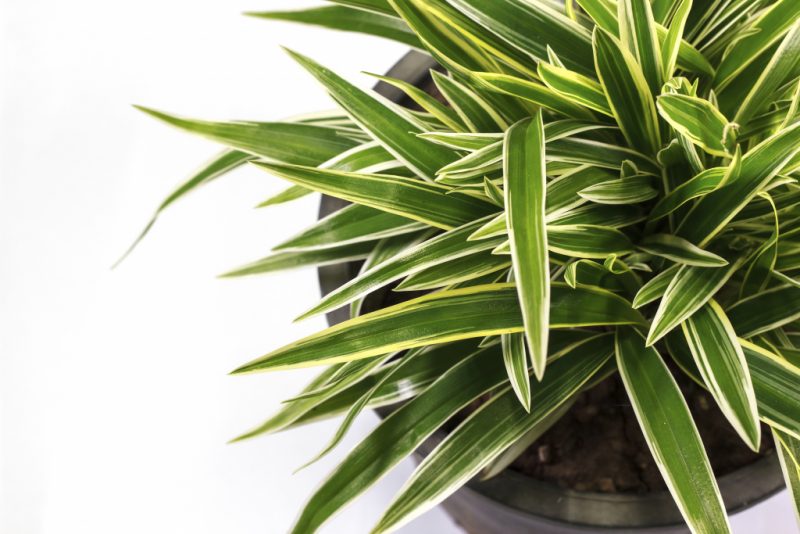
At home, flowering is extremely rare. If the phase has come, then after its completion, dried inflorescences should be removed.
Dracaena propagation in reliable and easy ways

Dracaena is propagated by several methods.
Propagation of dracaena by apical and stem cuttings

With the rejuvenation procedure:
- An apical shank 10-15 cm high with an oblique, smooth cut is prepared.
- The stem is slightly withered, treated with a growth stimulant and placed either in water or in a substrate.
- When rooting in water, its warm temperature and transparency are necessarily maintained.
- If the stalk is buried in the soil mixture, then it is covered with a package to create greenhouse conditions.
With stem cuttings, dracaena propagates in case of death of the apex as follows:
- Healthy segments are prepared that are placed vertically or horizontally in the ground.
- In the vertical method, the stalk is buried in the soil mixture for dracaena by 2 cm, after which it is sprinkled with a layer of sand of 5 cm
- In the case of using the horizontal method, the stem is pressed into the ground and slightly crushed by it.
- The container is covered with glass.
- After the emergence of shoots, indicating the successful formation of the root system, new specimens are planted in separate pots.
How to propagate by air layering

Another effective method of reproduction, in which:
- A thorough inspection of the stem is carried out, on which a transverse, rather deep incision is made at the location of the leaf.
- A toothpick is inserted into the damaged area to prevent tissue fusion.
- The injured area is covered with wet moss, which is fixed with a film.
- After the formation of aerial roots, the top is cut off and planted in a separate pot.
Seed propagation
In addition to vegetative techniques, reproduction can be carried out in a generative way. At the end of winter, the seeds are embedded in the soil, which is filled with individual cups, to a depth of 5 cm. The containers are covered with a film, which helps maintain the required temperature regime of 25-27 ° C. Also, one must not forget to systematically ventilate and spray crops. After germination, the protection is removed. Seedlings dive after they reach a height of 5-6 cm.
Pests, diseases and methods of dealing with them
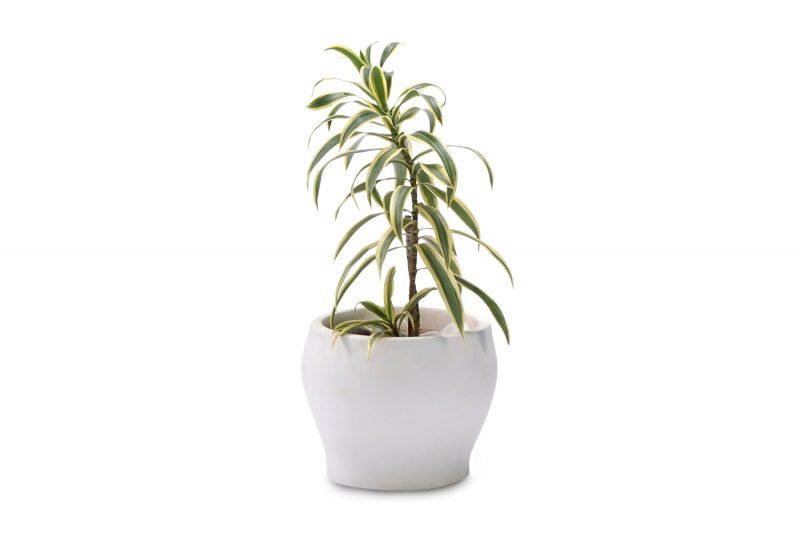
Dracaenes are resistant to disease damage. However, with systematic overflows, the development of such a fungal disease as gray rot is possible. In case of signs of root decay, the plant should be transplanted into a fresh, disinfected substrate, after removing the diseased parts of the root system. After transplantation, it is recommended to spray the dracaena flower with a fungicidal preparation according to the manufacturer's instructions indicated on the package. If brown spots appear on the leaves, then the irrigation regime should be reviewed, increasing the volume of water and frequency, as well as increasing the level of humidity. Black ovals indicate improper placement of the flower, suffering from direct sunlight.

Among the pests, the attacks of which, as a rule, are recorded with excessively low humidity, spider mites, scutes and thrips stand out. To quickly get rid of harmful insects, you should treat the Dracaena with an insecticide.
Attention! All treatments should be carried out in the fresh air with a pre-covered earthen lump.
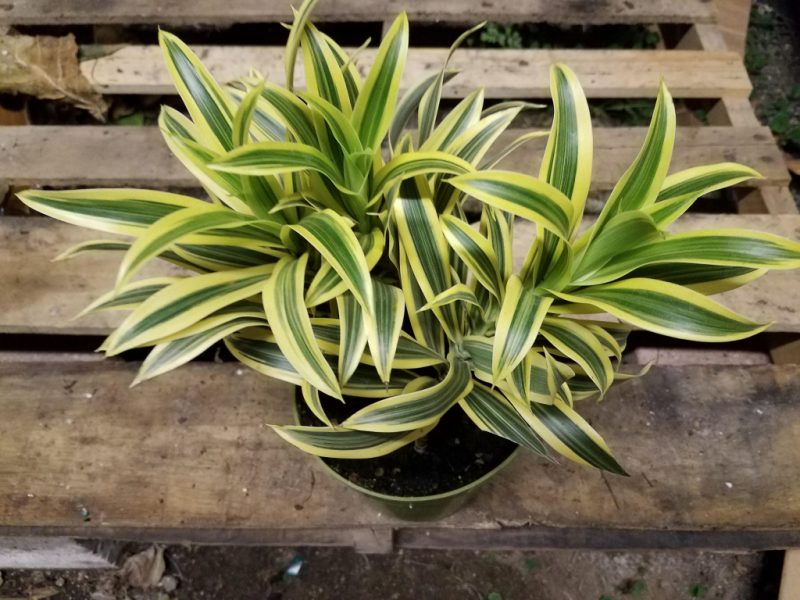
Thus, while ensuring the necessary conditions of detention and the implementation of simple care measures, even a novice gardener will be able to decorate an apartment or a winter garden with a popular plant with a spectacular bunch of decorative leaves.












